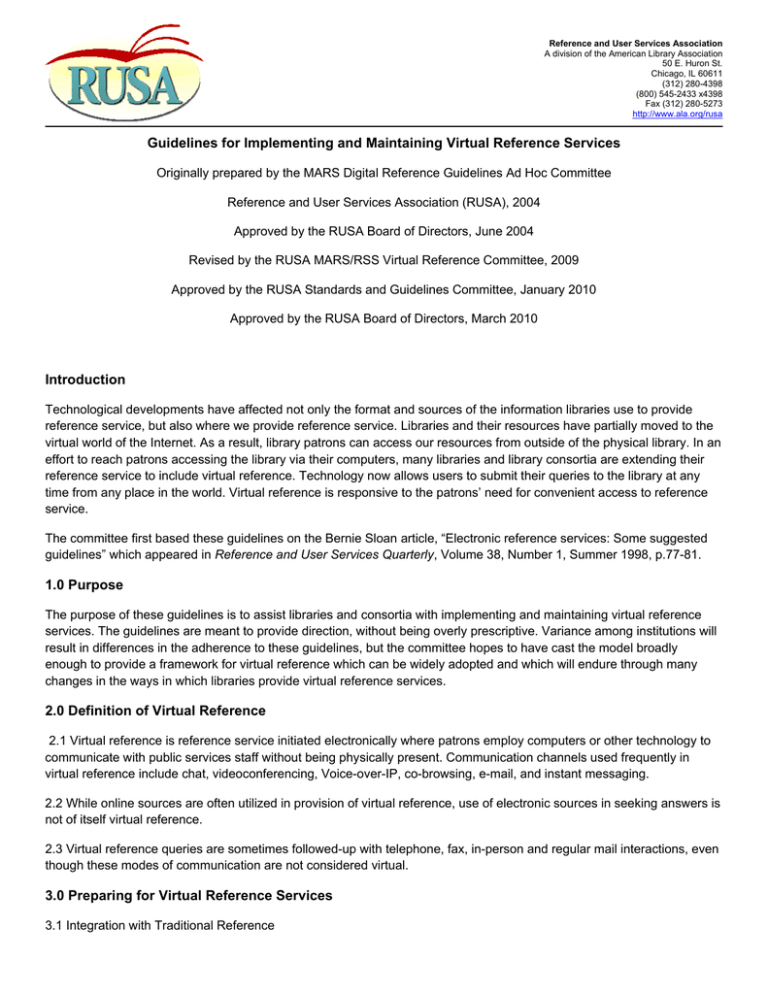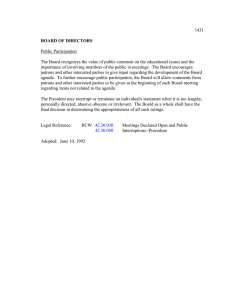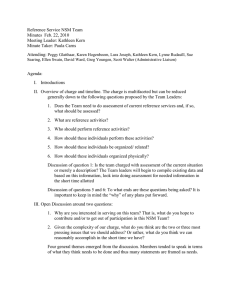Guidelines for Implementing and Maintaining Virtual Reference
advertisement

Reference and User Services Association A division of the American Library Association 50 E. Huron St. Chicago, IL 60611 (312) 280-4398 (800) 545-2433 x4398 Fax (312) 280-5273 http://www.ala.org/rusa Guidelines for Implementing and Maintaining Virtual Reference Services Originally prepared by the MARS Digital Reference Guidelines Ad Hoc Committee Reference and User Services Association (RUSA), 2004 Approved by the RUSA Board of Directors, June 2004 Revised by the RUSA MARS/RSS Virtual Reference Committee, 2009 Approved by the RUSA Standards and Guidelines Committee, January 2010 Approved by the RUSA Board of Directors, March 2010 Introduction Technological developments have affected not only the format and sources of the information libraries use to provide reference service, but also where we provide reference service. Libraries and their resources have partially moved to the virtual world of the Internet. As a result, library patrons can access our resources from outside of the physical library. In an effort to reach patrons accessing the library via their computers, many libraries and library consortia are extending their reference service to include virtual reference. Technology now allows users to submit their queries to the library at any time from any place in the world. Virtual reference is responsive to the patrons’ need for convenient access to reference service. The committee first based these guidelines on the Bernie Sloan article, “Electronic reference services: Some suggested guidelines” which appeared in Reference and User Services Quarterly, Volume 38, Number 1, Summer 1998, p.77-81. 1.0 Purpose The purpose of these guidelines is to assist libraries and consortia with implementing and maintaining virtual reference services. The guidelines are meant to provide direction, without being overly prescriptive. Variance among institutions will result in differences in the adherence to these guidelines, but the committee hopes to have cast the model broadly enough to provide a framework for virtual reference which can be widely adopted and which will endure through many changes in the ways in which libraries provide virtual reference services. 2.0 Definition of Virtual Reference 2.1 Virtual reference is reference service initiated electronically where patrons employ computers or other technology to communicate with public services staff without being physically present. Communication channels used frequently in virtual reference include chat, videoconferencing, Voice-over-IP, co-browsing, e-mail, and instant messaging. 2.2 While online sources are often utilized in provision of virtual reference, use of electronic sources in seeking answers is not of itself virtual reference. 2.3 Virtual reference queries are sometimes followed-up with telephone, fax, in-person and regular mail interactions, even though these modes of communication are not considered virtual. 3.0 Preparing for Virtual Reference Services 3.1 Integration with Traditional Reference 3.1.1 Treat virtual reference services as a long-term commitment to the targeted community. 3.1.2 Do not consider virtual reference an ad hoc or fringe service, even during the initial planning or pilot phases. 3.1.3 Integrate virtual reference services so that they become a natural part of the institution's reference services. 3.2 Commitment to Virtual Reference 3.2.1 Secure a commitment from a sufficient core of stakeholders at all levels of the institution's management and staff to support virtual reference service from its first planning stages through implementation before any project is attempted. 3.3 Costs of Virtual Reference 3.3.1 Commit, at the administrative level, to long-term provision of resources for virtual reference services. 3.3.2 Outline start-up costs including any software, training, or staff support. 3.3.3 Identify, at the administrative level, the impact to staffing and be prepared to make appropriate adjustments. 3.3.4 Document a clear understanding of the on-going maintenance costs associated with virtual reference and secure appropriate re-occurring budget allocations. 3.3.5 Identify and approve the costs related to marketing the virtual reference service. 3.3.6 Determine whether the service is to be free to the patron or fee-based before the service begins and modify as needed. 3.4 The Planning Team 3.4.1 Involve representative members of the administration and public services staff in planning, training, implementation, and promotion of virtual reference services and the selection of virtual reference software. 3.4.2 Involve representative members of the target audience in planning and promotion of virtual reference. 3.4.3 Identify and bring additional areas and services which will be affected by the new virtual service into discussions and planning as appropriate. 3.5 Selection of Software 3.5.1 Determine system compatibility, in addition to the reference requirements and budgetary constraints, imposed on the selection of virtual reference software. 3.5.2 Involve relevant computing staff in the planning, software selection, and purchase decisions. 3.5.2.1 Computing staff involvement will be critical for the smooth implementation and maintenance of the infrastructure needed for the virtual reference service and determination of its compatibility with existing library software and infrastructure. 3.6 Collection Development 3.6.1 Consider enhancement of the institution's electronic reference library in collection development decisions. 3.6.1.1 The availability of electronic reference sources significantly enhances the ability of the virtual reference librarian to identify or push out appropriate resources to the target audience. 3.6.2 Explore special licensing issues that might affect use of resources to serve off-site patrons. 3.7 Assessment 3.7.1 Facilitate regular assessment of the virtual reference program's effectiveness by library staff and administration. 3.7.2 Follow-through with the commitment to implement adjustments as needed when identified in the assessment process. 3.7.3 Assess virtual reference services in a comparable way to the institution's other reference services while acknowledging that virtual reference does have some unique features. 4.0 Provision of Service 4.1 Clientele 4.1.1 Define the patron population and publicize this policy on the library's web site or other places where patrons may access the service. 4.1.2 Address technical issues of patron authentication or proxy server login as they apply to various groups within the patron population. 4.1.3 Uniformly enforce institutional policies to exclude specific persons from the service. 4.1.4 Make guidelines for appropriate behavior while using the service available to patrons. 4.1.5 Clearly define the target audience(s) in the marketing plan of the service. 4.2 Parameters of Service 4.2.1 Define and announce the level of service to be provided so that staff and patrons will understand the mission of the service. 4.2.1.1 Level of service includes the types of questions the service will answer (perhaps easier to define in the negative), as well as the patron population the service will serve. 4.2.2 Establish guidelines before the service begins for determining which queries fall outside the parameters of service and how to respond in those cases. 4.2.3 Decide before the service begins if document delivery will be included and whether patrons will be charged for document delivery. 4.2.4 Determine and announce parameters of time to both patrons and staff. 4.2.4.1 For synchronous virtual reference, indicate the times at which the service is staffed. 4.2.4.2 For asynchronous virtual reference, give guidelines for how frequently queries will be checked or how soon an initial response can be expected. 4.2.4.3 For those times when the service is unstaffed or otherwise unavailable, guide users to other forms of reference. 4.2.5 Design internal and external links to the virtual reference service to catch the attention of potential patrons and to clearly communicate the nature of the service. 4.3 Personnel 4.3.1 Share virtual reference service responsibilities among staff to ensure continuity of service. 4.3.2 When possible, train staff for all reference services (face-to-face and virtual) to provide greater depth of knowledge and flexibility for staffing. 4.3.3 Select library staff conducting virtual reference on the basis of ability, interest, and availability. Service behaviors (as described in section 4.4) and skills to use the supporting technology need to be part of staff selection. 4.3.4 Provide time and resources to staff for training and continuing education to ensure effective service. 4.4 Service Behaviors 4.4.1 Virtual reference requires of library staff many of the same communication and interpersonal skills necessary for other forms of reference. The absence of a physically-present patron and the different modes of communication may call for additional skills, effort, or training to provide quality service on par with face-to-face reference services. 4.4.2 Exhibit the professional competencies essential for successful reference and patron services librarians as articulated in the RUSA “Professional Competencies for Reference and User Services Librarians.” 4.4.3 Maintain standard guidelines of reference service (such as reference interviewing, exchange of questions between services, et al.). 4.4.4 Follow interpersonal communication practices that promote effective provision of reference service as articulated in the RUSA "Guidelines for Behavioral Performance of Reference and Information Services Professionals.” 4.4.5 Require staff to demonstrate skills in the effective use of online communication, as well as demonstrate awareness of the common potential problem areas when conducting reference interviews online as compared to the face-to-face reference interview. 4.4.6 Offer initial and on-going training to help staff learn and retain these effective online behaviors. 4.4.7 Treat patrons’ and colleagues’ online communication, including stored transcripts or records, as private and confidential. 4.5 Collaborative Virtual Reference 4.5.1 Some libraries may choose to provide virtual reference services collaboratively with other libraries for various reasons including: to extend their hours of operation, to distribute staffing of the service across multiple libraries, to extend the expertise available, or to realize cost savings associated with economies of scale. Such collaboration may include working with virtual reference vendors or participation in large regional or national collaborations. 4.5.2 Take into account the interoperability of software platforms for ease of collaboration among virtual reference partners. 4.5.3 Clearly define expectations for libraries participating in a collaborative service before the local library commits to such a service. 4.5.4 Clearly define responsibility for centrally administering and coordinating the service. 4.5.5 Have each library appoint a project liaison to represent the library in the group’s activities. Clearly state expectations for the project liaison’s duties. 4.5.6 Clearly delineate procedures for communications between and among participants. 4.5.7 Have participating libraries commit to a prescribed minimum level of service. 4.5.7.1 For synchronous virtual reference, set a minimum number of service hours, based upon factors such as size of library or staff, patron population being served, budget, and extent of online reference service desired. 4.5.7.2 For asynchronous virtual reference, prescribe a minimum number of questions to be handled or monitoring of the queue for specific blocks of time. 4.5.8 Centrally administer scheduling of libraries' contributions to the service. 4.5.8.1 For synchronous virtual reference, have each library commit to specific blocks of time. It is the responsibility of the local library to find specific reference staff to fill these blocks of time, and not that of the project director. 4.5.8.2 For asynchronous virtual reference, have participating libraries commit to monitoring question queues for incoming questions in specific blocks of time. 4.5.9 Provide a central source of information on member library policies, operations, procedures, and regulations, so that it is simple for project reference staff to find information about other libraries. 4.5.10 Establish a clear set of guidelines for establishing priorities for service for patrons from the various libraries e.g., in a collaborative virtual reference service; questions are handled on a first-come-first-served basis, with no preference given to patrons from the on-duty staff’s own local library. 4.5.11 Establish clear policies and guidelines for using licensed online electronic resources to serve patrons from other participating libraries. (See Section 3.6.2) 4.5.12 Establish clear policies and guidelines that effectively ensure patron privacy in a multi-library setting. 5.0 Organization of Service 5.1 Integration of Virtual Reference Service 5.1.1 Virtual reference is an extension of an institution’s existing reference services. While staffing models and the location of the service may be different from face-to-face reference services, accord virtual reference service the same status and quality goals as face-to-face reference, and view it as a part of the larger service of reference. 5.1.2 It is a goal of all reference services to be of high quality. Integration of virtual reference into the mainstream of reference services implies that all services (in-person, telephone, and virtual) will be supported at a level to ensure quality service. 5.1.3 Examine staffing models to determine one that is appropriate for each library's organization. While there is not a “one-size-fits-all” service model, choose a model which would support quality reference interactions via all modes of communication. 5.1.4 Make all public services staff aware of the virtual reference service's goals and basic operation. 5.1.5 Establish procedures for referring a virtual patron (i.e., question) to another reference or public services point. Include procedures for both how the referral is presented to the patron and how information about the referral is communicated between the virtual reference desk and referral destination. 5.2 Infrastructure/Facilities 5.2.1 Provide staff with space, furnishings, hardware, and software to accomplish the mission agreed on by staff, administration, and technology support staff. 5.2.2 Update equipment, facilities, and software as needed to maintain efficacy. Take into account the continuing evolution of technology. 5.2.3 Take into account awareness of the patrons' infrastructure and capabilities when planning library capabilities and choosing virtual reference software. 5.2.4 Take into consideration use of the supporting software by patrons and reference staff with disabilities. Some options include choosing software that complies with Section 508 of the Rehabilitation Act (“Nondiscrimination under Federal grants and programs: Electronic and information technology,” Title 29 U.S. Code, Pt. 794d 2004 ed.), software with nontext options such as Voice-over-IP, or providing text on the Web site that directs screen-readers to an email form or alternate contact information. 5.3 Finances 5.3.1 Include in the library budget specific allocation of funds to cover the personnel, hardware, software, connectivity, furnishings, training, publicity, and space to support this service. 5.3.2 Include on-going budgeting even when the service is started as a pilot or with seed money from a grant. 5.5 Marketing 5.5.1 Develop and implement a marketing plan as part of the planning and on-going operation of the service. 5.5.2 Determine a target audience or audiences for the virtual reference service and market to that audience appropriately. Include members of the target audience in the planning and evaluation of marketing. 5.5.3 Establish a budget for marketing and assign publicity as a responsibility to a staff member or members. 5.5.4 Routinely evaluate and update marketing to keep the message fresh, reach new audiences, and publicize new developments or access methods for the service. 5.6 Evaluation and Improvement 5.6.1 Evaluate the effectiveness and efficiency of the virtual reference service regularly using input from staff and patrons with the goal of providing a high-quality service. 5.6.1.1 Evaluation may encompass many methods such as the analysis of usage statistics, patron feedback, and reviewing transcripts. 5.6.3 Make evaluation of the virtual reference service equivalent to and part of the library’s regular evaluation of all reference services. 5.6.4 Use evaluation to improve the service as needed through adjustment of staffing, levels of staffing, service parameters, training, or other improvements as indicated by evaluation and assessment results. 6.0 Privacy 6.1 Treat virtual reference communications between patrons and library staff as private except as required by law. 6.2 Protect patrons' confidentiality in data gathered and maintained for the purpose of evaluation. 6.2.1 Strip patrons’ personal identifiers, such as name, e-mail, etc., from transaction records. Stripped records may be maintained for statistical and evaluative purposes. 6.2.2 Develop retention schedules and privacy policies for their virtual reference transactions. 6.2.3 Advise patrons whether a record of the transaction will be retained, and what, if any, personal information will be stored with the transaction log. 6.2.4 Make privacy policies and transcript retention schedules publicly available. 6.3 Take care when using reference transactions in the creation of databases and FAQs to maintain the privacy of patrons and the confidentiality of patrons’ inquiries. 6.3.1 Evaluate transcripts, beyond removal of patron identifiers, when choosing them for inclusion in a database so as not to compromise patron confidentiality. 6.3.2 Inform patrons, through publicly-available policy, that their questions might be included in a database. Provide a means for patrons to request removal of their inquiries from the database. 6.4 Protect patron confidentiality in data gathered and maintained for training purposes and for publicizing the service. Bibliography Reference and User Services Association. Guidelines for Behavioral Performance of Reference and Information Services Professionals. Approved by the RUSA Board of Directors, June 2004. (http://www.ala.org/ala/mgrps/divs/rusa/resources/guidelines/guidelinesbehavioral.cfm) Reference and User Services Association. Professional Competencies for Reference and User Services Librarians. Approved by the RUSA Board of Directors, January 26, 2003. (http://www.ala.org/ala/mgrps/divs/rusa/resources/guidelines/professional.cfm) Sloan, Bernie. Electronic reference services: Some suggested guidelines. Reference and Users Services Quarterly, 38(1), 77-81. Summer 1998. Electronic version, reproduced with the permission of the American Library Association. MARS Digital Reference Guidelines Ad Hoc Committee (2004) Kathleen Kern, co-chair Bernie Sloan, co-chair John Glace Lori Morse Janice Rice Jana Ronan Kris Stacey-Bates MARS/RSS Virtual Reference Committee (2009) Alicia Korenman, MARS co-chair Crystal Lentz, RSS co-chair Don Boozer Beth Cackowski Alisa Gonzalez Ellen Hampton Crystal Renfro Johannah White




